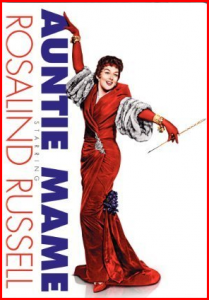Topical Categories
Archives
Innovation is a Banquet! –So Why Are So Many Leaders Starving to Death?!
I’m actually taking great liberties with the classic quote, “Life is a banquet, but most poor  suckers are starving to death!" from Patrick Dennis’s book and Broadway hit, “Auntie Mame.”
suckers are starving to death!" from Patrick Dennis’s book and Broadway hit, “Auntie Mame.”
My point being that although there are countless ways to engage our creative problem-solving brains to innovate day in and out, I am not optimistic that the majority of Americans in the business, non-profit, or governmental sectors will access this cornucopia before a lot more damage is done to our economy, environment, quality of life, and future potential.
For many, the word “innovation” is just a buzzword. They fail to understand that innovation is a state of mind and an approach, not a commodity that one can just order up, like a pizza, or flip on with a switch. Thinking that one can just make a few minor adjustments within one’s organization to become innovative is like having an argument on the cell phone while driving 90 miles an hour to get to a retreat center, and expecting serenity or enlightenment to be waiting at the door upon one’s arrival – It just doesn't happen that way.
And this is why it is projected that by the year 2020, only one out of five S&P 500 companies will still exist (findings of a comprehensive study published in Creative Destruction by R. Foster and S. Kaplan). The majority of companies simply will not have adapted to the changing world, and will therefore make themselves vulnerable to being taken over, sold off, broken up, or bankrupted.
 I’m currently listening to the audiobook, That Used to Be Us: How America Fell Behind in the World It Invented and How We Can Come Back, co-authored by international journalist Thomas Friedman (author of the blockbuster The World is Flat) and American foreign policy professor Michael Mandelbaum. Like the authors, I consider myself to be a “realistic optimist.” By which we mean that it is only by clearly taking in the “bad news” — the looming threats facing our companies, institutions, and economy — that we have any chance to do what is necessary to adapt our mindsets and correct our course.
I’m currently listening to the audiobook, That Used to Be Us: How America Fell Behind in the World It Invented and How We Can Come Back, co-authored by international journalist Thomas Friedman (author of the blockbuster The World is Flat) and American foreign policy professor Michael Mandelbaum. Like the authors, I consider myself to be a “realistic optimist.” By which we mean that it is only by clearly taking in the “bad news” — the looming threats facing our companies, institutions, and economy — that we have any chance to do what is necessary to adapt our mindsets and correct our course.
Like Friedman and Mandelbaum, I too, still believe in “Yankee Ingenuity” and that we have the collective capacity to rise to the occasion and deal with great challenges, just as Americans did in The Great Depression, World War II, and the race to the moon. But we can’t even begin until we pull our heads out of the sand.
When it comes to business, I am enough of a capitalist to believe in the survival of the fittest. On one hand, I believe that companies led by short-sighted, arrogant leaders and managers should fail. It’s best f or them to get out of the way to make room for other ventures led by those who are wiser, more humble, and better attuned to both the world around them and to the intelligence and talents within their ranks.
or them to get out of the way to make room for other ventures led by those who are wiser, more humble, and better attuned to both the world around them and to the intelligence and talents within their ranks.
The tragedy won't be the auctioning off of the brick and mortar and mastheads of these companies themselves over the next decade. Rather, it will be the human costs resulting from the bad choices made by those leaders: the millions of talented people who will lose their jobs and livelihoods, as well as the loss of tax revenues that will further cripple our society.
And then “four out of five” of these US companies will fail?! – Even if it were half that (e.g. 51% of CEO's in the 2010 IBM CEO study expressed concerns regarding their companies' futures for lack of creative thinking abilities) — what part of economic catastrophe do we still not understand?! Neither manufacturing jobs or increasingly outsourced pink and white collar services will be returning from our lower-cost overseas competitors in any significant numbers. That leaves American creativity and inventiveness to carry our economy forward. Yet we allow Brazil, India, and China to far outspend us in innovation (Boston Consulting Group Report, 2010) as the previously unchallenged lead we held in patent application filings now steadily shrinks. http://economix.blogs.nytimes.com/2010/10/06/china-poised-to-lead-world-in-patent-filings/ & http://www.wipo.int/pressroom/en/articles/2012/article_0001.html
CEO's in the 2010 IBM CEO study expressed concerns regarding their companies' futures for lack of creative thinking abilities) — what part of economic catastrophe do we still not understand?! Neither manufacturing jobs or increasingly outsourced pink and white collar services will be returning from our lower-cost overseas competitors in any significant numbers. That leaves American creativity and inventiveness to carry our economy forward. Yet we allow Brazil, India, and China to far outspend us in innovation (Boston Consulting Group Report, 2010) as the previously unchallenged lead we held in patent application filings now steadily shrinks. http://economix.blogs.nytimes.com/2010/10/06/china-poised-to-lead-world-in-patent-filings/ & http://www.wipo.int/pressroom/en/articles/2012/article_0001.html
Even among those in management who are talking about innovation, many don’t seem to grasp the irrefutable causal relationship between management style and innovative culture. I don’t believe that most American managers or the consulting professionals upon whom many of them rely, understand this fundamental reality: sustained innovation cannot exist in hierarchical, siloed, watch-your-back organizations.
“Management innovations” are necessary in order for other forms of innovation to see the light of day. It has been stated in numerous ways throughout these blog-posts that an organizational culture that fosters an innovative mindset and which produces winning results requires authentic mutual trust and respect throughout the organization. As the stand-out CEOs in the IBM 2010 Global CEO survey (“Capitalizing on Complexity”) indicated, trust and innovation are the means and ends and involve:
- Cross-departmental and external stakeholder collaboration
- Efficient and open communication in which mistakes are valued as educational opportunities rather than
 something to be covered up or blamed on someone else
something to be covered up or blamed on someone else - Comfort with ambiguity, experimentation, and trial by error
- Encouragement to question the status quo for the sake of continuous improvement
- Processes and reward systems for fully engaging employees in contributing ideas for continuous improvements and increasing problem-solving autonomy throughout the ranks.
All of these necessitate a collaborative, versus a command-and-control style of management. Evidence abounds that the most successful U.S. companies (like Southwest Airlines, Google, and Apple) flatten their organizations and, far more than average companies, value and foster both the creativity and critical analysis of “whole brain” thinking at all levels.
Yet evidence and logic do not persuade many in leadership whose perceptions continue to be clouded by barriers of their own making. I am not optimistic that most organizational leaders in the U.S. are willing to trust and develop their employees’ abilities enough to relinquish control, because, as is said in Twelve-Step programs, their pain isn’t deep enough yet. –If only their poor choices wouldn’t inflict so much pain on the rest of us.
However… despite my concerns expressed above, as a dedicated realistic optimist, I will continue to focus my attention not on those who stubbornly fail to grasp the paradigm shifts that are necessary, but rather on the great innovators in all walks of life working with their creative muses and collaborating all over the world. I will feed my spirit and mind by exploring and learning along with those equally excited by the possibilities and the array at the banquet table!
Bon appetite!
Mangia!
The next post will further explore management innovation with a review of Gary Hammel’s great Harvard Business School article, “The Why, What, and How of Management Innovation.”
Enjoy this three-minute creative educational video by Explania on the many benefits of employee engagement and how organizations can cultivate it. http://www.explania.com/en/animations/detail/how-to-use-employee-engagement-to-boost-your-business
As “illustrated” in this video, "engaged" employees means those who regularly go the “extra mile” because they carry energy and passion for the organizational vision and take great pride in their work and the contributions they make towards the mission and goals. They take initiative and serve as examples to other staff. They tend to have stronger relationships with customers, building sales and boosting reputation, and they promote the organization to others.
Sadly, even among the organizations that take care of the basic employee satisfaction areas (fair pay, reasonable management, and reasonable working situations), according to the statistical research cited by Explania, engagement is as low as 20% in the average organization. However, in innovative organizations, the number of engaged employees is eight times greater than those that are average. The video attributes recognition, leadership, education and professional opportunities as drivers for engagement.
All good, and spot on!… The only lacking I see is that there is no mention of a) what makes organizations innovative or b) the role of employees’ contributions of ideas in any of the areas discussed on this blog: process improvements, marketing, services, or products.
What this clever little video does not mention is that employees need to know their ideas and opinion are valued in order to feel respected in order be willing to or have the option to fully engage all of their talents, and for the organization to be an innovative one. –The authors probably meant that as well, but the oversight was probably a simple “slip of the pen.” 😉
Cheers!
The next post will look at collaboration, which, as has been previously stated, is lifeblood to creative problem-solving and innovation in organizations. Fruitful collaboration can only be built on a foundation of trust, and that, only from authentic relationships.
To the latter point, I want to start by sharing some poetry and prose by two writers which speaks to the humanity that connects us in our day-to-day working relationships, and the need to affirm this. For me, as for many, I believe that connection is related to spirit or spirituality, which I define as: that which is invisible to the eye, but which binds us to life, to our creative spirit, and to one another.
In Indian culture, "namaste" means, "I honor the divinity within you."
The Hindus greet one another by bowing with folded hand against the breastbone. This miniceremony means: “I salute the divinity within you.”
No workplace can be truly alive until we see the divinity within one another, until we experience behind the breastbone the breath of life, until we insist that our work will not be the humdrum product of a sleeping spirit but a glorious monument to who we really are.
John Cowan
from The Common Table
Threads
Sometimes you just connect,
like that,
no big thing maybe
but something beyond the usual business stuff.
It come and goes quickly
so you have to pay attention,
a change in the eyes
when you ask about the family,
a pain flickering behind the statistics
about a boy and a girl in school,
or about seeing them every other Sunday.
An older guy talks about his bride,
a little affectation after twenty-five years.
A hot-eyed achiever laughs before you want him to.
Someone tells about his wife’s job
or why she quit working to stay home.
An older joker needs another laugh on the way
to retirement.
A woman says she spends a lot of her salary
on an au pair
and a good one is hard to find
but worth it because there’s nothing more important
than the baby.
Listen.
In every office
you hear the threads of love and joy and fear and guilt,
the cries for celebration and reassurance,
and somehow you know that connecting those threads
is what you are supposed to do
and business takes care of itself.
Jame A. Autry
from Love & Profit
- Adapting to Change & overcoming Fear
- Ambiguity and embracing the Unknown
- Apple and/or Steve Jobs
- Business Reports: 2010 IBM CEO & 2010 BCG
- Changing Cultures to become Innovative
- Collaboration vs. Silos
- Continuous Improvement or Process Improvement
- Creative Arts & Innovation
- Creative Genius among Staff
- Creative Problem Solving
- Creative Thinking Practices & Exercises
- Creativity/Innovation
- Critical Thinking
- Curiosity & Asking Questions
- Divergent vs. Convergent thinking
- Employee Engagement
- Fun and innovation
- Hierarchy vs. Innovation
- How to Think Like Leonardo da Vinci
- Innovation & the Economy
- Innovation in Government
- Innovation in History
- Integrity; Following own drummer
- Langdon Morris
- Leadership & Management Best Practices
- Learning from Mistakes
- Lifelong Learning and innovation
- Mentoring and innovation
- Model Innovative Organizations
- Podcasts on innovation
- Processes and Structures for Innovation
- Redefining Innovation
- Scenario Planning
- Six Sigma and LEAN vs. innovation
- Social Change and Innovation
- Spirituality in Workplace and innovation
- Trust and Respect in Engagement and Innovation
- Types of Innovation
- Weirdness and Creativity
- What-iffing
- Whole Brain Thinking
- YouTube Videos

